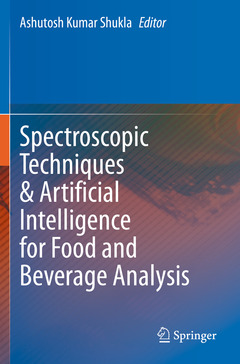Description
Spectroscopic Techniques & Artificial Intelligence for Food and Beverage Analysis, 1st ed. 2020
Coordinator: Shukla Ashutosh Kumar
Language: English
Subjects for Spectroscopic Techniques & Artificial Intelligence for...:
Spectroscopic Techniques & Artificial Intelligence for Food and Beverage Analysis
Publication date: 08-2021
121 p. · 15.5x23.5 cm · Paperback
Publication date: 08-2021
121 p. · 15.5x23.5 cm · Paperback
Spectroscopic Techniques & Artificial Intelligence for Food and Beverage Analysis
Publication date: 08-2020
Support: Print on demand
Publication date: 08-2020
Support: Print on demand
Description
/li>Contents
/li>Biography
/li>Comment
/li>
This informative book discusses the various spectroscopic techniques applied in the analysis of food and beverages. The respective chapters cover techniques such as Laser-Induced Breakdown Spectroscopy (LIBS), FTIR spectroscopy, Electron Spin Resonance (ESR) spectroscopy and Thermoluminescence. The book also presents artificial intelligence applications that can be used to enhance the spectral data analysis experience in food safety and quality analysis.
Given its scope, the book will appeal to novice researchers and students in the area of food science. It offers an equally exciting read for food scientists and engineers working in the food industry.
Chapter 1: Laser Induced Breakdown spectroscopy in food analysis.- Chapter 2: The use of FTIR spectroscopy combined with multivariate analysis in Food composition Analysis.- Chapter 3: Spectrophotometric methods and Electronic Spin Resonance for evaluation antioxidant capacity of food.- Chapter 4: Thermoluminescence the method for the detection of irradiated foodstuffs.- Chapter 5: Advantages of Multi-target modeling for spectral regression.
Dr. Ashutosh Kumar Shukla is an Associate Professor of Physics at Ewing Christian College, University of Allahabad, India. In addition to journal publications, he also has a textbook and many edited volumes on e.g. Medicine, Food Science and Crude Oil to his credit. Dr. Shukla has successfully completed research projects and presented his findings at various international events. He serves on the reviewer panel for numerous international journals; is a member of the International EPR Society (IES); and is a web member of the International Society of Magnetic Resonance (ISMAR).
Demonstrates how mathematical modeling can enrich spectral data analysis
Includes multi-target regression methods used to enhance the spectral data analysis experience
Interdisciplinary in focus, it will appeal to a broad audience
© 2024 LAVOISIER S.A.S.
These books may interest you

Undergraduate Instrumental Analysis 105.47 €


